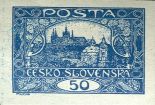Means of transportation
This sub-collection contains materials originated in the area of Bohemia, Moravia, Silesia, Austria, Italy, England and Germany. The bulk are cars, coaches and sleighs dating back to between the second half of the 18th and first half of the 20th century. The sub-collection is based on materials from the estate of former Žamberk postmaster Kamil Schopf, purchased in 1926. The 26 hippomobile vehicles makes it one of the largest museum collections of its kind in the Czech Republic.
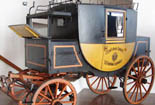
A landauer coach with folding roof from the property of the Schwarzenbergs and later Wallensteins (built in the first third of the 19th century by London-based firms Barker&Co. and Thrupp) and a Berlingot coupé used by Austrian Emperor Ferdinand I during his long-time stay at Prague following his abdication in 1848 are the highlights of the sub-collection. An 1860 coach from Žamberk built to carry both passengers and mail or a classic mail coach built in Milano some ten years later belong to the typical postal vehicles. Some of the preserved parcel cars were used by the Austrian Post as early as around 1900; the next-generation cars were produced in Czechoslovakia in the 1930s.
The sub-collection also includes a separate set of several types of sleighs. The large horse-drawn postal sleigh, originally also from Žamberk, was built to carry both mail and passengers; the hand sled, used by the Bakov nad Jizerou post office to carry mail, was built in the 1930s and represents the most common type of sleighs, particularly in mountainous regions. The seahorse-shaped sled, cut from a single piece of wood, represents the type of leisure sleighs. Further materials held in this sub-collection include horse gear (e.g. an 18th-century ceremonial breast plate and harness for a team of four horses) and smaller things, such as coach lanterns, traveller luggage and models of horse-drawn cars and postal buses.
Photo gallery
-
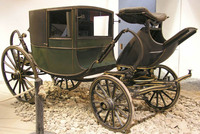 Berlingot coupé used by Austrian Emperor Ferdinand I the Benign
Berlingot coupé used by Austrian Emperor Ferdinand I the Benign Berlingot coupé used by Austrian Emperor Ferdinand I the Benign
Dvoumístný kočár využíval rakouský císař Ferdinand I. (1793-1875) po abdikaci roku 1848 během mnohaletého pobytu v Praze. Tažen byl dvěma nebo čtyřmi koňmi, je vybaven kozlíkem pro kočího a plošinou pro dva lokaje stojící v zadní části vozu. Poštovnímu muzeu ho roku 1930 daroval Památník osvobození.
-
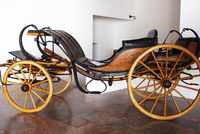 Victoria-type pleasure coach
Victoria-type pleasure coach Victoria-type pleasure coach
Dvouspřežní výletní kočár typu Victoria pro dvě osoby pochází z majetku knížecího rodu Metternichů, jehož erb je umístěn na bocích korby. Vůz je vybaven držáky na lampy, nad zadní nápravou má připevněno sedadlo pro služebnictvo, pod nímž se nachází úložná schránka. Vyroben pařížskou firmou Geibel v 50. letech 19. stol.
-
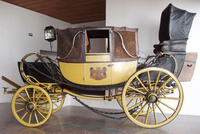 Luxury aristocratic coach
Luxury aristocratic coach Luxury aristocratic coach
Reprezentativní šlechtický kočár byl vyroben někdy v období vymezeném přibližně lety 1804-35 londýnskými firmami Barker & Co. a Thrupp. Jeho vlastníkem byl vévoda z Newcastle. V roce 1838 se kočár dostal do majetku Jana Adolfa II. knížete ze Schwarzenberku (1799-1888), který jej nechal opravit, aby se v něm následně zúčastnil jako vyslanec rakouského císaře Ferdinanda I. korunovace královny Viktorie 28. června téhož roku. Dalším majitelem kočáru se stal Arnošt František, hrabě z Valdštejna (1821-1904), podnikatel a podporovatel výstavby železnic v Čechách, který se roku 1851 oženil s Marií Leopoldinou, dcerou Jana Adolfa II.
-
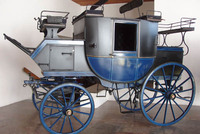 Italien-made stagecoach
Italien-made stagecoach Italien-made stagecoach
Čtyřspřežní dostavník celkem pro deset cestujících byl vyroben ve 2. pol. 19. stol. společností Cesare Sala v Miláně, jejíž počátky sahají až do období kolem roku 1800.
Ve 2. polovině 19. století se stala nejvýznamnějším italským výrobcem kočárů, mezi jehož odběratele patřil i římský a vídeňský dvůr. Později se firma věnovala výrobě karosérií pro automobily Alfa Romeo, Fiat a Isotta Fraschini.
-
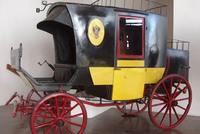 Mail coach from Žamberk
Mail coach from Žamberk Mail coach from Žamberk
Dvouspřežní rakouský poštovní vůz pro přepravu až čtyř cestujících a zásilek má dřevěnou konstrukci pobitou plechem a je natřen v rakouských státních barvách (žluté a černé). Boky korby zdobí malba císařského orla se zavěšenou trubkou ve žlutém oválu. Na střeše je umístěna ohrádka pro zavazedla, součástí vozu jsou rovněž i dvě uzamykatelné schránky. Vyroben byl kolem roku 1860.
-
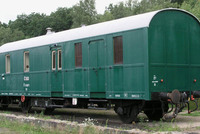 • F 5054 00-20 065-3 travelling post office (TPO) van
• F 5054 00-20 065-3 travelling post office (TPO) van F 5054 00-20 065-3 travelling post office (TPO) van
Vůz vlakové pošty se dostal do Poštovního muzea z Ředitelství poštovní přepravy Praha poté, co byl vyřazen z provozu. Naposledy byl nasazen v okrsku Jihozápadní dráhy Československých státních drah. Vůz byl vyroben pravděpodobně v roce 1929 v německé vagónce v Budyšíně (Bautzen) a do ČSR se asi dostal po II. světové válce, kdy byl zařazen do vozového parku jako konfiskát. Jde o dvounápravový vůz s ocelovou karoserií, natřený zeleným nátěrem ČSD včetně všech předpisových nápisů. Interiér je rozdělen na kancelář, sklad a toaletu. V roce 1999 bylo dokončeno kompletní restaurování, včetně technické revize, v Železničních opravnách v Krnově. Vůz je plně provozuschopný a v současnosti je deponován v železničním muzeu v Lužné u Rakovníka.
-
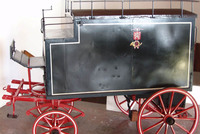 Parcel mail coach used by the Czechoslovak Post
Parcel mail coach used by the Czechoslovak Post Parcel mail coach used by the Czechoslovak Post
Balíkový vůz Československé pošty z roku 1928, používaný k rozvozu balíkových zásilek ve větších městech. K zápřahu se používal buď jeden, nebo dva koně. Nákladní prostor tvoří dřevěná skříňová korba pobitá plechem, na jejíž bocích je vyobrazeno logo státního podniku Československá pošta (státní znak ČSR s poštovním rohem, zavěšeným na stuze).
-
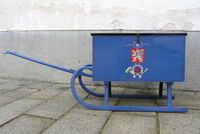 Hand-drawn mail sled
Hand-drawn mail sled Hand-drawn mail sled
Saně sloužily k dopravě zásilek mezi poštovním úřadem Dolní Bousov u Mladé Boleslavi a tamním vlakovým nádražím. Jedná se o ojedinělý doklad přepravy poštovních zásilek pomocí ručních saní, který zatím nebyl v našem prostředí hmotně, obrazově ani písmeně doložen. Vzhledem k barevnému provedení nátěru a umístění znaku státního podniku Československá pošta (český lev s poštovním rohem zavěšeným na trikolóře) lze saně datovat do období po roce 1925, kdy byl úřední znak zaveden pro poštovní silniční vozidla.

 Berlingot coupé used by Austrian Emperor Ferdinand I the Benign
Berlingot coupé used by Austrian Emperor Ferdinand I the Benign  Victoria-type pleasure coach
Victoria-type pleasure coach  Luxury aristocratic coach
Luxury aristocratic coach  Italien-made stagecoach
Italien-made stagecoach  Mail coach from Žamberk
Mail coach from Žamberk  • F 5054 00-20 065-3 travelling post office (TPO) van
• F 5054 00-20 065-3 travelling post office (TPO) van  Parcel mail coach used by the Czechoslovak Post
Parcel mail coach used by the Czechoslovak Post  Hand-drawn mail sled
Hand-drawn mail sled ![Postal museum [logo]](/PostMuzeum-theme/images/muzeum/logo_postal-museum.png)
